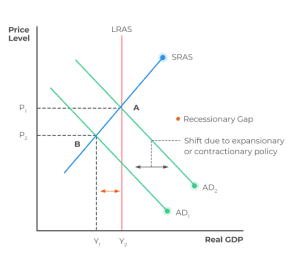Aggregate Demand and Supply
AD/AS Image
AD/AS Equilibrium Changes Over Time
Macroeconomic fluctuations follow a four-step process: initial shock, shifts in aggregate demand (AD) or aggregate supply (AS), new equilibrium, and policy response (Mankiw, 2024). In both the Great Recession (GR) and the COVID-19 recession, there was a sharp decline in AD due to financial instability and widespread lockdowns (COVID-19). Referring to the AD/AS model in the diagram, the economy initially operated at equilibrium A, where AD intersected SRAS and LRAS: Aggregate Demand and Supply.
The recession caused a leftward shift from AD₂ to AD₁, leading to lower output (Y₁ instead of Y₂) and lower price levels (P₂ instead of P₁). Consequently, this shift resulted in a recessionary gap, as shown in the diagram. Over time, expansionary policies helped shift AD back toward equilibrium.
Comparison of Gross Domestic Product During Both Crises
Gross domestic product (GDP) declined significantly in both recessions. During the Great Recession, GDP fell by approximately 4.3% from its peak (2007 to 2009), while in 2020, it dropped by 9.1% in the second quarter alone, recovering quickly afterward (Mankiw, 2024).
Policy Responses to the Crises
The U.S. government responded to the GR with fiscal stimulus packages, the Troubled Asset Relief Program (TARP), and monetary easing. In contrast, the COVID-19 response included direct stimulus payments, expanded unemployment benefits, and business support programs like the Paycheck Protection Program (PPP) (Scott & Cano, 2024).
Source of Future Macroeconomic Growth in the U.S.
Future growth will likely be driven by technological innovation, infrastructure investment, and labor market improvements (Scott & Cano, 2024). Government policies supporting sustainable energy, supply chain resilience, and digital transformation will be crucial in fostering long-term economic stability.
References
Mankiw N. G. (2024). Principles of economics (10th ed.). Cengage Learning.
Scott, J., & Cano, S. (2024). Sports in principles of economics textbooks. Managerial Finance. https://doi.org/10.1108/mf-06-2024-0471
ORDER A PLAGIARISM-FREE PAPER HERE
We’ll write everything from scratch
Question
Recently, there have been comparisons between today’s economy and the 2008–2009 Great Recession (GR). Some argue that the COVID-19 pandemic recession is materially different from the GR, while others argue there are many parallels. As you learned in your reading, policymakers in both eras were confronted with a sudden decrease in aggregate demand.
In your initial post, draw or find an example of the aggregate demand and aggregate supply (AD/AS) model that illustrates the general trends of the U.S. economy during both crises. The example may be from your research or the textbook (see Chapter 34).
In addition to your image, respond to the following:

Aggregate Demand and Supply
- Using the four steps for analyzing macroeconomic fluctuations, explain how the AD/AS equilibrium changed over time. Support your claims by referring to your AD/AS model’s AD shift.
- Select an economic factor (GDP, unemployment, or housing price level) and compare its values during both crises.
- What policies and strategies did the U.S. government use to deal with the GR and then to deal with COVID-19?
- What do you see as the source of future U.S. macroeconomic growth?
In your response posts, comment on at least two posts from peers who chose different factors than you did. Explain how the economic factors are related. Share a news article that presents a different perspective on the economic outcomes of the crises from your peers’ perspectives.


